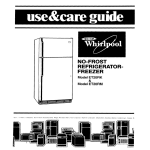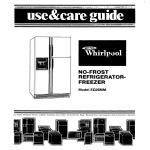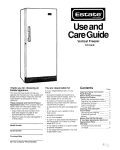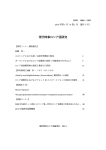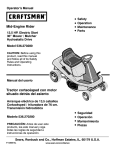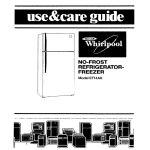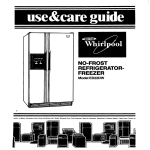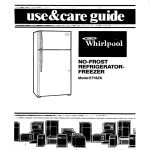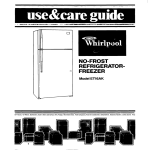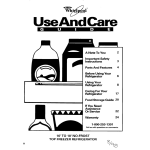Download Whirlpool ED25DW Specifications
Transcript
NO-FROST REFRIGERATORFREEZER Model ED25DW reezers. Ice Makers. DIshwashers BullI-In Ovens and Surface Units. Ranges. Mwowave Ovens. Trash Compaclors. Room Air Cond~l~oners. Oehumldlliers Aulomallc Washers. Clothes Dryers. Freezers. Please read this Use and Care Guide before you do anything else... This booklet tells you how to start your. refrigerator, clean it, move shelves and adjust controls. It even tells you what new sounds to expect from your refrigerator. Treat your new refrigerator with care. Use it only to do what home refrigerators are designed to do. Parts and features POWER SAVER CONTROL FREEZER CONTROL REFRIGERATOR CONTROL 4 IM 1111 FTp-il IIiIIiW I ItsIT MODEL AND SERIAL NUMBER -. _-- AUTOMATIC ICE MAKER [not shown1 ADJUSTABLE FREEZERBASKETS ADJUSTABLE ADJUSTABLE BASE GRILLE HUMIDITY CONTROLS Thank you for buying a Whirlpool appliance. Please complete and mail the Owner Registration Card provided with this product.Then complete the form below Have this information ready if you need service or call with a question. l l Copy Model and Serial Numbers from plate [see diagram above) and purchase date from sales slip. Keep this book and sales slip together in a handy place. Model Number Serial Number Purchase Date Service Companv 2 Phone Number Contents 6 6 Page 7 7 7 7 8 8 9 11 11 11 CLEANING YOUR REFRIGERATOR. ...... 12 Cleaning Chart ..................... 13 FOOD STORAGE GUIDE ................ 13 Storing Fresh Food .................. 14 Storing Frozen Food ................. 17 VACATION AND MOVING CARE ........ 18 IF YOU NEED SERVICE OR ASSISTANCE. 6 WHIRLPOOL REFRIGERATOR WARRANTY ............................ Page 3 SAFETY FIRST .......................... Important Safety Instructions ......... 3 BEFORE USING YOUR REFRIGERATOR. .. 4 Remove Sales Labels ................ Clean It ............................. Plug It In ............................ Install Properly ...................... Level Refrigerator-Freezer ........... USING YOUR REFRIGERATOR ........... Setting the Controls. ................. Changing the Control Settings ....... Power Saver Control ................. Adjusting the Crisper Humidity Control ........................... Adjusting Meat Drawer Temperature Adjusting the Refrigerator Shelves ... Removing Crispers, Meat Drawer and Covers ....................... 4 4 4 4 4 5 5 5 5 6 Removing the Snack Bin ............. Adjusting the Wine Rack ............ Removing the Freezer Baskets ....... Adjusting the Door Bins .............. Changing the Light Bulbs ............ Removing the Base Grille ............ Cold Water and Ice Dispenser ...... Sounds You May Hear ................ Energy Saving Tips .................. 20 01988 Whirlpool Corporation Important Safety Instructions You are personally responsible that your refrigerator... l l l for making sure is installed and leveled on a floor that will hold the weight,and in an area suitable for its size and use. is connected only to the right kind of outlet, with the right electrical supply and grounding. (Refer to your “Electrical Requirements and Grounding Instructions:‘) is used only to do what home refrigerators are designed to do. l l l l l l is not near an oven, radiatoror other heat source. is properly maintained. is out of the weather. is used in an area where the room temperature will not fall below 55°F (13°C). is not used by anyone unable to operate it properly. is not loaded with food before it has time to get properly cold. Before using your refrigerator 4. Install properly... / lIri-lII 1. Remove sales labels... Remove the Consumer Buy Guide label, tape and any inside labels before using the refrigeraglue: tor. To remove any remaining 1L I I 1. Rub briskly with thumb to make a ball then remove. OR 2. Soak area with liquid hand dishwashing detergent before removing glue as described in step 1. DO NOT USE rubbing alcohol or flammable or toxic solvents, such as acetone, gasoline, carbon tetrachloride, etc. These can damage the material. NOTE: DO NOT REMOVE ANY PERMANENT INSTRUCTION LABELS INSIDE YOUR REFRIGERATOR. Do not remove the Tech sheet fastened under the refrigerator at the front. 2. Clean it... Clean cleaning your refrigerator before instructions on page 8. using it. See 3. Plug it in... 3-PRONG GROUNDING TYPE WALL RECEPTACLE 1. Allow Y2inch (1.25 cm) space on each side and at the top of the refrigerator for ease of installation. 2. If the refrigerator is to be against a wall, you might want to leave extra space so the door can be opened wider. 3. The refrigerator back can be flush against the wall. 4. Make sure ice maker water supply has been connected. Refer to Installation Instructions. 5. Level re’frigerator-freezer... USE SCREWDRIVER TO ADJUST FRONT ROLLER REFRlGERAiOR POWER CORD RECOMMENDED 3-PRONG GROUNDING PLUG GROUNDING METHOD A 115Volt. 60 Hz., AC only 15 or 20 ampere fused and properly grounded electrical supply is required. It is recommended that a separate circuit serving only this appliance be provided. Do not use an extension cord. Use a receptacle which cannot be turned off with a switch or pull chain. See individual electrical requirements and grounding package. 4 instruction sheet in your literature 1. Remove base grille (see page 8). 2. To raise front, turn screw in direction shown. 3. To lower front, turn screw in direction shown. 4. Check with level. 5. Replace base grille (see page 8). Using your refrigerator FREEZERCbNfROL POWiR SAVER CONTROL REFRlGERATdR CONTROL LIGilT SWITCH Setting the controls... Controls forthe refrigerator and freezer are in the refrigerator. When the refrigerator is plugged in for the first time... 1. Set the REFRIGERATOR CONTROL to 3.2. Set the FREEZER CONTROL to B., Changing the control settings... REASON: eral hours.) right for ~Is -~~x-~ ~~~~~- l l Adjust the Refrigerator Control first. Wait at least 24 hours between adjustments. Then adjust the Freezer Control if needed. RECOMMENDED SETTINGS: L.“,ZI_U .-PI ,m .-s.F+:. . , CONTROL Door opened often Section is Large amount of food added TOO WARM Room temperature.-aIn~.-*-~l-..r~..~iC too warm IYuI-o-~-L.~-*I~.m If Freezer Door opened often Section is Large amount of food added TOO WARM Very cold room temperature often enough) /n_c.xQUESTIONS? _L_ c /-ma,.7 [can’t L-T cycle-/:mxall your If Refrigerator Controls not set correctly COOL-LINE” Section is for your conditions service TOO COLD ..*I_**.. - Z”, >,_a I I,.>,.,_< Y1-m,,-” _.,.. I .-...-assistance Heavy ice usage telephone If ICE isn’t MADE FASTENOUGH Very cold room temperature number (can’t (Page 18). -c.*I,..sw*Y_ ?lWJ.d.li -. . cycle often enough] If BOTH SECTIONS Door opened often are TOO WARM Large amount of food added Very warm or very cold room temperatures 1c . -~li* 11 le-L1.-re- * -8~-, .. ,--*.*.m >...aa., e ,\,v.:.--1-,.-m I-“*?‘% 8__1, The Power Saver saver Control control on the rnf Control Console operates an electric heater between belweer the door openings. This heater helps keep moisture from moi *’ 1 forming on the outside of the the- refrigerator. nor- The controls will be set about right when milk or juice is as cold as you like and when ice cream is firm. -,.Ly~lli w =..-I Power Saver Control... time to cool down comfood. (This may take sev- These settings should be about mal household rerngeraror usage. l If you need to adjust temperatures in refrigerator or freezer, use the settings listed in the chart below. i CONDITION: L‘-I-muu, i If Refrigerator Give the refrigerator pletely before adding ,_Lli il.l Refrigerator Freezer .., 4 A I 3 C Refrigerator Freezer _ ,i-- s, - ,“S * Sl_. ns--* 1-m. Refrigerator Freezer . 1 ~..- I ^ -~ i a .. 4 1 Refrigerator Freezer 4 B .lW . 1. Use the “CONSUMES LESSENERGY”setting when humidity is low. 2. Use the “REDUCESEXTERIORMOISTURE”setting if moisture forms on the outside of the refrigerator. The indicator light will glow when the switch is in the “REDUCESEXTERIORMOISTURE” position. .- Adjusting the crisper humidity control You can control the amount of humidity in the moisture-sealed crisper. 1. The control can be adjusted to any setting between LOW and HIGH. 2. LOW [open] lets moist air out of crisper for best storage of fruits and vegetables with skins. 3. HIGH (closed) keeps moist air in the crisper for best storage of fresh leafy vegetables. . / ’ Adjusting meat drawer temperature... USE CONTROL TO ADJUST MEAT DRAWER TEMPERATURE Adjusting the refrigerator shelves... SPILLGUARDshelves can be adjusted to match the way you use your refrigerator. Glass shelves are strong enough to hold bottles, milk and other heavy food items. Cold air flows against the meat drawer through an opening between the freezer and the refrigerator. This helps keep the meat drawer colder than the rest of the refrigerator. Setthe control to let more or less cold airthrough. To remove glass 1. Lift up front. shelves: 2. Slide shelf out with an even, constant pull to the stop, lift front and slide the rest of the way out. To replace glass shelves: 1. Guide rear of shelf into shelf guide. 2. Slide shelf in with an even, constant motion to the stop, lift front and slide the rest of the way in. To move shelf guides: 1. Remove shelf. 2. Lift front of guide, pull guide off rear support. Repeat for other guide. 3. Replace in reverse order. GLASS SHELVES ARE HEAVY. BE CAREFUL. Removing the crispers, meat drawer and covers... To remove the crispers and meat drawer: 1. Slide crispers and meat drawer straight out to the stop. Lift the front, then slide the rest of the way out. 2. Replace in reverse order. To remove the covers: 1. Lift front of cover off supports. PULL OUT TO THE STOP LIFTTHE FRONT AND PULLAGAIN. 2. Lift out cover by pulling up and out. To replace l the covers: Fit back of cover in notch supports on walls of refrigerator, then lower into place. NOTE: Glass crisper. cover will fit only above full width LIFT THE COVER FRONT, \ THEN THE BACK. GLASS IS HEAVY, BE CAREFUL. 6 Removing- the snack bin... To remove the snack bin: 1. Slide snack bin with an even, constant motion straight out to the stop. 2. Lift the front. 3. Slide bin the rest of the way out. 4. Replace in reverse order. PULL OUT TO THE STOP, LIFT THE FRONT AND PULL AGAIN. To move the wine rack: 1. Lift front of wine rack. 2. Pull rack off rear support. 3. Replace in reverse order. Removing the freezer baskets... To remove a basket: 1. Slide out to the stop. 2. Lift the front to clear the stop. 3. Slide out the rest of the way. To replace a basket: 1. Place basket on the slides. 2. Make sure the wire stops clear the front of the slides. 3. Slide basket in. PULL OUT TO THE STOP, LIFT THE FRONT AND PULL AGAIN. Adjust ing the door bins... To remove a door bin: 1. Lift bin straight up. 2. Pull bin straight out. To replace a door bin: 1. Slide bin straight in above guides. 2. Push bin straight down. I NOTE: large bins are designed tion of refrigerator door only. to fit in top por- Changing the light bulbs... To change refrigerator light: 1. Reach behind the control console to find bulb. To change crisper light: 1. Pull top of light shield forward until it snaps free. 2. Remove bulb. 3. Replace with a 40-watttubularappliance 2. 3. 4. 5. To change portment: light behind quick freeze bulb. com- Lower light shield to clear bottom supports. Pull light shield straight out to remove. Replace bulb with a 40-watt appliance bulb. Replace light shield in reverse order, To change light below ice bin: 1. Push in sides of light shield until it snaps free. 2. Replace bulb with a 40-watt appliance bulb. 3. Replace the light shield. 1. Lift and secure quick freeze compartment door, 2. Remove light shield by pulling top forward. 3. Replace bulb with a 40-watt appliance bulb. 4. Replace the light shield. To change dispenser light: 1. Reach the bulb through the dispenser area 2. Replace with a heavy duty IO-watt bulb. Removing the base grille... To remove r the grille: METAL CLIPS \ SUPPORT TABS SUPPORT TABS 1. Open the doors. To replace 2. Pull grille outwards as shown. 3. Do not remove Tech sheet fastened grille. 4. Line up grille support tabs with metal clips. 2. Push firmly to snap into place. 3. Close the doors. 8 behind the grille: Cold water and ice dis FOR ICE: Press o sturdy FOR CHILLED WATER: Press a sturdy glass against glass agolnsl the water dispenser bar. (Pressure can break o fragile gloss.) Remove the glass to stop dispensing. Dispense enough water every week to maintain a fresh supply. the ice dispenser bar. (Pressure and tumbling ice can break o fragile glass ] Remove the glass to stop dispenslng The first few batches of Ice from the Ice maker may have a bad taste from new plumbing and parts. Throw them away Press against Ice Dispenser Bar The small tray beneath spills. There is no drain the dispenser is deslgned to evaporate in this tray. Do not pour water into it. Ice Is dlspensed from the ice maker storage bin in the freezer. When the dispenser bar is pressed, a trapdoor opens in a chute between the dispenser and the ice bin. Ice is moved from the bin and falls through the chute. When the dispenser bar is released, a faint buzzing sound may be heard for a few seconds. small Chilled water comes from a tank behind the meat drawer. It holds about 50 ounces (1.5L). When the refrigerator is first hooked up press the water dispenser with a glass or jar until you have drawn and discarded 2 or 3 quarts (1.9 to 2.8L). The water you draw and discard will rinse the tank and pipes. Allow several hours to chill the first tankful. NOTE: large amounts of ice should be taken from the bin, not through the dispenser. Common Problems PROBLEM Dispenser won’t work Ice dispenser work. won’t CAUSE SOLUTION Freezer door open. l Ice bin not properly installed. Wrong ice in bin. Close the freezer door. l Make sure bin is pushed all the way in. l Use only ice crescents from ice maker. Other shapes won’t dispense properly. Ice dispenser working. stops Ice dispenser bar held in too long. l l Off-taste in ice. or odor Ice attracts airborne odors. Old ice. Water quality Wait about 3 minutes for the dispenser motor to reset. Large amounts of ice should be taken from the bin, not through the dispenser. Use rapidly or store in covered container. Dump old ice and make new supply. l Water containing minerals (such as sulfur] may require a filter to remove. l Wrap properly. See pages 14 and 15. l Clean freezer and ice bin. See Cleaning Chart on page 12. 0 Follow installation instructions for proper ice maker water supply hook-up. l The first few loads of ice from a new ice maker may have an off-taste. Dump ice and make new supply. l l Foods not properly wrapped. Ice bin and freezer may need cleaning. Plumbing to ice maker. New ice maker TIPS l l l l l The dispensers will work only with the freezer door closed. The Ice dispenser will work only if the bin is pushed all the way in. Use only Ice cresoents from the ice maker. Other shapes won’t dispense properly. When you need more ice than a glass or two, scoop it fram lhe bin or remove the bin. The dispenser motor may stop if the dispenser bar Is held In too long. It will be ready to run again in about 3 minutes. Ice stored too long can go stale-like water. Throw it away. Ice can shrink. Cold moving air slowly evaporates them. If you use ice often, you may never notice the change. 0 Good water quality is important for good ice quality. It is not recommended that the ice maker be connected to a softened water supply. Watersoffenerchemicals such as salt from a malfunctioning softener can damage the ice maker mold and lead to poor quality ice. If a softened water supply cannot be avoided, then it is important that the water softener be well maintained and operating properly. l continued on next page 9 Plan to remove l l l and empty the storage bin: If the ice dispenser has not, or will not be used for a week or more; If a power failure causes ice in the bin to melt and freeze together; If the ice dispenser is not used regularly. 1. Pull the covering panel out from the bottom and slide it to the rear. 2. Lift the signal arm so it clicks into the OFF position. Ice can still be dispensed, but no more will be made. Night 3. Lift the front of the storage bin. Pull it out. 4. Empty the bin. Use hot or warm water to melt the ice if necessary. Never use anything sharp to break up ice in the bin. This can damage the bin and dispenser mechanism. 5. Wash with mild detergent. Rinse well. Do not use harsh or abrasive cleansers or solvents. 6. When replacing the bin, make sure it is pushed in all the way. Push the signal arm down to the ON position to restart ice production. 10 light S light uses a heavy-duty IO-watt bulb. When it burns out, purchase another from Your dealer. The night Sounds you may hear... Your new refrigerator may make sounds that your old one didn’t. Because the sounds are new to you, you might be concerned about them. Don’t be. Most of the new sounds are normal. Hard surfaces like the floor, walls and cabinets can make the sounds seem louder. The following chart describes the kinds of sounds that might be new to you, and what may be making them. -- 8 . _ : -, -.i ,r.LiA iL Possible Sounds: _ )n_ .--, .i.IIIY.ivli * l Slight Hum, Soft Hiss: l l l l <_* .. _>I _.(1._. .d,.,.c_ Probable _ “eww,,P -a . Causes:’ !.I. .-,..L -.*, ” b. 1 ..>l:lll You may hear the refrigerator’s fan motor and moving air. ,~._./YL,I~~i+Fs-l..a ew_j”.,PI 1 .I , . .,_ -.*, * . , The thermostat makes a definite click when the-refrigerator stops running. Clicking or Snapping It also makes a sound when the refrigerator starts. The defrost timer Will Sounds: click when the defrost cycle starts and stops. ,.. -j _ -z=.~ilxI~~.,~.~I.c.~~w I.I~L”YIIYIIzI. rX-m.wrI.”.,_, I ,r When the refrigerator stops running, you may hear gurgling in the tubing Water Sounds: for a few minutes after it stops. You may also hear defrost water running into the defrost pan.,, ,, :, water ._ 3.L/. -111 rj. i .,I,.... .,.<.,~,Pxa*.,~~ When the ice maker is running you may hear buzzing (from the water Ice Maker Sounds: valve], trickling water and the clatter of ice dumped into the bin. - trickling water - thud (clatter of ice) ,, ,.-. I_llr . ....-r ; Running Sounds: .I. Your refrigerator has a high-efficiency compressor and motor. It will run longer than older designs. It may even seem to run most of the time. Energy saving tips... You can help your refrigerator use less electricity. l Check door gaskets for a tight seal. Level the cabinet to be sure of a good seal. l Clean the condenser coil regularly. l Open the door as few times as possrble. Think about what you need before you open the door. Get everything out at one time. Keep foods organized so you won’t have to search for what you want. Close door as soon as food is removed. l Go ahead and fill up the refrigerator, but don’t over crowd it so air movement is blocked. I/_ 8...-A12..:* I l l l It is a waste of electricity to set the refrigerator and freezer to temperatures colder than they need to be. If ice cream is firm in the freezer and drinks are as cold as your family likes them, that’s cold enough. Keep the Power Saving Control on CONSUMES LESSENERGYunless moisture forms on refrigerator exterior. Make sure your refrigerator is not next to a heat source such as a range, water heater, furnace, radiator or in direct sunlight. Cleaning your refrigerator Both the refrigerator and freezer sections defrost automatically. But both should be cleaned about once a month to help prevent odors from building up. Of course, spills should be wiped up right away. To clean your refrigerator turn the Refrigerator Control to OFF, unplug it, take out all removable parts and clean it according to the following directions. continued on next page 11 Cleaning chart... mm.- , Part s”_ ,,meI- ..lq.,ml- Removable parts (shelves, crisper, meat drawer, bins, freezer baskets, etc.) _~l_I~_---Iy,_,/_-~Outside What to use How to clean Sponge or cloth; mild detergent and warm water. em--. Sponge, cloth or paper towel;mild detergent; appliance wax [or good auto paste wax]. l l l cleansers. Rinse and dry. Wax painted metal surfaces at least twice a year with appliance wax or a good auto paste wax. Apply wax with a clean, soft cloth. Do not use wax on plas- l l ,-I _.r c iP>l,”e‘sq^jlm----_I Waxing painted metal tic parts. surfaces provides Inside walls (Freezer should be allowed to warm up so cloth won’t stick.) Sponge, soft cloth or paper towel, baking soda, warm water, mild detergent. l se..a.~PYyIILDoor liners and gaskets __I__Sponge, soft cloth or paper towel, mild detergent, warm water. l I .=s- b._dr/_Y___,, Dark plastics (covers and panels] ls.~-e.--‘.~as-+.r-..~-~~-.:~.* -a-w--sE.w Defrost pan rust protection. --Wash with warm water and - mild detergent or - baking soda (2 tablespoons [26 g] to 1 quart [.95 L.] warm water). Rinse and dry. --lx-Wash with mild detergent and warm water. Rinse and dry. l l DO NOT USE Cleaning waxes, concentrated detergents, or cleansers containing petroleum on plastic parts. K detergent and warm water; soft clean sponge and soft, clean cloth. l l bleaches Wash with a soft cloth 0; sponge. Rinse and dry. --- DO NOT USE paper towels, window sprays, scouring cleansers, or flammable or toxic solvents like acetone, gasoline, carbon tetrachloride, etc. These can scratch or damage the material. Sponge or cloth; mild detergent and warm water. l l l l l l __,1_,--__.~~.~=.-“,-- +m.m_y___/wf~i Condenser Coil Vacuum cleaner; using the extended narrow attachment. l e.:vwim A.zcpil ,,vII/ -II.wm-.S-.~lz?mb--,-~~Floor under refrigerator Usual floor cleaners. l l l l l l l 12 Wash removable parts by hand x warm water and a mild detergent. Rinse and dry. Wash with warm water and a mild detergent. Do not use abrasive or harsh R Remove base grille. [See page 8.) To remove defrost pan, lift pan over wire brace (remove tape; if any). Wash defrost pan with warm water and mild detergent. Rinse and dry. Replace with notched corner to the rear. Push it all the way in. Make sure defrost drain tube is pointing into pan. Replace base grille. Remove base grille. Clean dust and lint from condenser at least every other month. Replace base grille. __I__-= Roll refrigerator out only as far as water supply line allows. Clean the floor. Roll refrigerator back. Check to see if the refrigerator is level. Food storage guide There is a right way to package and store refrigerated or frozen food. To keep food fresher, longer, ta ke the time to study these recommended steps. STORING FRESH FOOD Cured or Smoked Meat and Cold Cuts. Ham, bacon, sausage, cold cuts, etc., keep best in original wrappings. Once opened, tightly re-wrap in plastic wrap or aluminum foil. Canned Ham. Store in refrigerator unless the label says it’s okay to store on the shelf. Do not freeze. Fresh Poultry...Wrap in plastic wrap. The plastic on poultry, as purchased, may be used for storage. Leaty Vegetables...Remove store wrapping and trim or tear off bruised and discolored areas. Wash in cold water and drain. Place in plastic bag or plastic container and store in crisper.Cold, moist air helps keep leafy vegetables fresh and crisp. Vegetables with Sklns (carrots, peppers)...Store in crisper, plastic bags or plastic container. Frult...Wash, let dry and store in refrigerator in plastic bags or crisper. Do not wash or hull berries until they are ready to use. Sort and keep berries in their store container in a crisper, or store in a loosely closed paper bag on a refrigerator shelf. I STORAGE CHARTFORFRESHAND CUREDMEAT’ We Variety Meats ....................... ............................ Chlcken Ground Beef ........................ Steaks and Roasts .................. Cured Meats ........................ Bacon .............................. Cold Cuts ........................... Time Ways1 1 to 2 1 to 2 1 to 2 3 to 5 7 to 10 5to 7 3to 5 ‘If meat is to be stored longer than the times given, follow the directions for freezing. NOTE: Fresh tlsh and shellflsh same day as purchased. Meatf..Meat is perishable and expensive...you won’t want to waste an ounce of it through careless handling. The following list and chart give you packaging hints and time limits. Store meat in the meat drawer. Fresh, Prepackaged Meat. Store fresh meat in the store wrapping. Vacuum packaged meat can be frozen for as long as one month if the seal is not broken. If you want to keep it frozen longer, you should wrap it with special freezer wrapping material. Fresh Meat, Not Prepackaged. Remove the market wrapping paper and re-wrap in aluminum foil for storing it unfrozen. Cooked Meat. Wrap or cover cooked meat with plastic wrap or aluminum foil. Store immediately. Approximate should be used the Eggo...Store without washing in the original carton on interior shelf. Mllk...Wipe milk cartons. For best storage, place milk on interior shelf. Beverages...Wipe bottles and cans. Store on a door shelf or inside the refrigerator. Butter...Keep opened butter in covered dish or in the Utility Compartment. When storing an extra supply, wrap in freezer packaging and freeze. Cheese...Store in the original wrapping until you are ready to use it. Once opened, re-wrap tightly in plastic wrap or aluminum foil. Condlments...Store small jars and bottles (catsup, mustard, jelly, olives) on the door shelves where they are in easy reach. Leftovers...Cover leftovers with plastic wrap or aluminum foil to keep food from drying out and transferring food odors. Plastic containers with tight lids are fine, too. 13 STORING FROZEN FOOD The freezer section is designed for storage of commercially frozen food and for freezing food at home. Packaging -The secret of successful freezing is in the packaging. The wrap you use must be air, moisture and vapor proof. The way you close and seal the package must not allow air, moisture or vapor in or out. Packaging done in any other way could cause food odor and taste transfer throughout the refrigerator and drying of frozen food. Rigid polyethylene (plastic] containers with tight fitting lids, straight-sided canning/freezing jars, heavy-duty aluminum foil, plastic-coated paper and nonpermeable plastic wraps (made from a Saran film) are recommended. NOTE: Heat- l sealed boiling bags are easy to use and can be used by themselves or as carton liners. Sealing - When sealing food in bags, squeeze out the air (liquids need headspace to allow for cause food odor and taste transfer ing of frozen food. DO NOT USE: Bread wrappers Non-polyethylene plastic containers l Containers without tight lids l Waxed paper l Waxed-coated freezer wrap l Thin, semi-permeable wrap None of these are totally moisture, air or vapor proof. The use of these wrappings could l and dry- expansion). Twist the top and turn it back. Fasten tie securely around the doubled-over tail. Put the label inside transparent bags; use self-adhesive label on outside of opaque ones. Air-tight wrapping calls for “drugstore” wrap. Cut the sheet about one-third longer than the distance around the food. Bring the ends together and fold in (toward the food] at least twice to seal out air. Crease ends close to food, press air from package. Fold tips over twice. Finish package and tape closed. NOTE: With unboned meats, pad sharp edges with extra wmp or use stockinette tect the wrap from punctures. 14 to pro- Freezlng Fruits - Select ripe, blemish-free fruits. Be sure they taste as good as they look. Wash 2 to 3 quarts (liters) at a time and drain. Fruit thatstands in water may lose food value and become soggy. Sort, peel, trim, pit and slice as needed. Pack in rigid wide-mouthed containers or other recommended material. Leave head space to allow liquids to expand during freezing. Freezing Vegetables - Freeze only fresh highquality vegetables picked when barely mature. For best results, freeze no more than 2 to 3 hours after picking. Wash in cold water, sort and cut into appropriate sizes. Blanch or scald. Pack in recommended container and freeze. Do not freeze lettuce, celery, carrot sticks, potatoes or fresh tomatoes. All will become limp or mushy. Tomatoes will collapse when thawed. Freezing Meats - The meat you thaw can only be as good as the meat you freeze. “Drugstore” wrap in meal-size packages. Flat cuts or patties should be wrapped individually or in layers separated by a double thickness of freezer wrap. Make sure store wrappings are moisture and vapor proof. If not, re-wrap meats with one of the wraps recommended under “Packaging:’ Freezing Cooked Food-Prepare cooked foods as you would forthe table; shorten cooking time 10 to 15 minutes to allow for additional cooking during reheating. Omit seasonings and part of the liquid. Plan to add them at reheating time. Potatoes should also be added to soup and stew at heating time. Add crumb and cheese toppings at heating time. Cool as rapidly as possible and freeze at once. Liquid or semi-liquid dishes may be frozen in recommended containers with head-space. Casseroles and other more solid foods may be frozen in the baking container. If you don’t want to leave your casserole dish in the freezer, line it with foil. Bake, cool, freeze, lift out the foil package, bag it and return to freezer Freezing Baked Goods - Wrap baked breads in recommended material. Thaw in wrapping. Unbaked yeast breads can be frozen after the first rising. Punch down, wrap and freeze. Bake cookies as usual. Cool and freeze on trays, then pack in recommended freezer bags or cartons. Unbaked cookies may be dropped, molded or rolled and frozen on cookie trays. Store in bag or carton; bake without thawing Refrigerator-type cookies can be wrapped and frozen in roll form. Thaw only enough to slice when ready to bake. Fruit pies are best frozen unbaked. Bake without thawing. Bake pecan and similar pies before freezing...rich fillings do not freeze solid. Cu? steam vents in top crusts when ready to bake. 15 IMPORTANT: Do not expect your freezer to quickfreeze any large quantity of food. Put no more unfrozen food into the freezer than will freeze within 24 hours. (No more than 2 to 3 pounds of food per cubic foot of freezer space.) leave enough space for air to circulate around packages. Be careful to leave enough room at the front so the door can close tightly. FOOD STORAGECHART Storage times’ will vary according to the quality of the food, the type of packaging or wrap used (moisture and vapor-proof), and the storage temperafure which should be 0°F ( 17.8”C). Food Storage lime FRUITS ........ 12 months Fruit juice concentrate 12 months Commercially frozen fruit ..... ...... 4 to 6 months Citrus fruit and juices 8 to 12 months Others. .................... VEGETABLES Commercially frozen .......... 8 months 8 to 12 months Home frozen .............. MEAT 4 weeks or less Bacon .................... 4 weeks or less Corned beef ............. (Salting meat shortens freezer life) ..................... 1 month Frankfurters Ground beef, lamb, veal ... 2 to 3 months Roasts: 6to12 months Beef .................... 6 to 9 months lamb and veal .......... 4to8months Pork ..................... 1 to 2 months Sausage, fresh ............. Steaks and chops: 8to42months Beef .................... 3 to 4 months lamb, veal, pork ......... FISH Cod, flounder, haddock 6months Sole ......................... ........... 2 to 3 months Blue fish, salmon ........... 2 to 3 months Mackerel, perch ..... 3 months Breaded flsh (purchased). Clams, oysters, cooked ....... 3 to 4 months fish, crab, scallops 10 months Alaskan king crab ............ Shrimp, uncooked ............ 12 months POULTRY Chicken or turkey, whole or parts .............. 12 months Duck .......................... 6months 2to3months Giblets .................... ....... 6 months Cooked poultry w/gravy ................ 1 month Slices (no gravy) MAIN DISHES Stews; meat, poultry ....... 2 to 3 months and fish casserole 3 to 6 months TV dinners ................. Food Storage Time DAIRY PRODUCTS 6 to 9 months Butter ...................... ..................... 12 months Margarine Cheese: Camembert, Mozzarella, .................... 3 months farmer’s ...... Creamed cottage DO NOT FREEZE Cheddar, Edam, Gouda, Swiss, brick, etc. ........ 6 to 8 weeks Freezing can change texture of cheese. 2 months Ice cream, ice milk, sherbet ..... EGGS ................. 12 months Whole (mixed) 12 months Whites ......................... 12 months Yolks ........................... :Add sugarorsalt to yolks oFwhole mixed eggs) BAKED GOODS 3 months Yeast breads and rolls .......... 3 months Baked Brown ‘N Serve rolls ...... ................ 1 month Unbaked breads .............. 2 to 3 months Quick breads ........... 2 to 4 months Cakes, unfrosted ............ 8 to 12 months Cakes, frosted .................... 12 months Fruit cakes 3 months Cookie dough ... , .............. ............ 8 to 12 months Baked cookies 1 to 2 months Baked pies ................. 4 to 6 months Pie dough only ............. ‘Based on U.S.D.A. and Michigan Cooperative Extension Service suggested storage times If electricity goes off Call the power company Ask how long power WII be off I. If service IS to be Interrupted 24 hours or less, keep both doors closed This will help frozen foods to stay frozen 2. If service IS to be Interrupted longer than 24 hours (a] Remove all frozen food and store In CI frozen food locker Or. (b) Place 2 Ibs (0 9 kg] of dry ice in freezer for every cu ft of freezer space. This will keep frozen foods for 2 to 4 days Wear gloves to protect your hands from dry ice burns [c] If neither food locker storage nor dry ice IS available, use or can perishable food at once 3. A full freezer will stay cold longer than a partly filled one.AfreezerfulI of meatwill stay cold longer than a freezer full of baked goods. If food contains ice crystals, it may be safely refrozen, although the quality and flavor may be affected. Use refrozen foods quickly. If the condition of the food is poor or if you feel it is unsafe, dispose of it. Vacation Short vacations... Moving... No need to shut off the refrigerator if you will be away for less than four weeks. Use up perishables; freeze other items. 1. Turn off your ice maker. 2. Shut off the water supply to the ice maker. 3. Empty the ice bin. 4. Make sure all ice crescents are dispensed out of the mechanism. Shutoff theicemakerwatersupplyadayahead of time. Disconnect the water line. After the last supply of ice drops, lift the signal arm to turn off the ice maker. Make sure all ice crescents are dispensed out of the mechanism. Remove all food.Pack frozen foods in dry ice. Unplug the refrigerator and clean it thoroughly. Remove everything that comes out. Wrap all parts well and tape them together so they don’t shift and rattle. Also, remove the water supply tank behind tht meat drawer by: 1. Disconnecting water inlet and outlet tubes a the top of the tank. 2. Removing three mounting screws from the tank. 3. Draining the tank. Long vacations... Remove all the food if you are going for a month or more. At least a day ahead, turn off the water supply to the ice maker. When the last load of ice dropsturnoff the ice maker. Makesure all icecrescents are dispensed out of the mechanism. Unplug the refrigerator and clean it...rinse well and dry. Tape rubber or wood blocks to the tops of both doors...keeping them open far enough for air to get in. This will keep odor and mold from building up. Re-install the empty tank, and remember to check for tight water connections when the refrigerator is hooked up at your new location. Screw in the levelling rollers; tape the doors shut; tape the electric cord to the cabinet. When you get to your new home, put everything back, level the refrigerator, reconnect the water supply and refer to page 4. Questions? To restart refrigerator, erator:’ see “Using Your Refrig- call your CCCL-LINE * set-me assistance telephone number (page 93 1. 17 If you need service or assistance, we suggest you follow these five steps: 1. Before calling for assistance... 2. If you need assistance?.. Performance you can find and problems often result from lIttIe things fix yourself wlthout tools of any kind If your refrigerator Is the proper l will not operate: electric voltage’ cord plugged [See page Have you checked breaker box? l Is the l If there sounds: your Refrigerator into 4 ) home’s Confrol is a rattling Is something noise when l on top or behind the refrigerator If your ice maker Is the l signal Is the water maker? l If there had enough this might arm ON valve is water circuit main fuses noise or unfamiliar or circuit the refrigerator running? IS time fo get take overnight With a 01 APPLIANCES~HOUSEHOLDMAJOR-SERVICE 8 REPAIR ELECTRICAL APPLIANCESMAJOR - REPAIRING 8 PARTS position? on7 Is water in the defrost cold’ If YOU need service?.. Whtrlpool has a nationwide r network of franchised TECH-CARE service companles TECH-CARE service d technicians are trained to fulfill the TECU-CARE FRANCHISED SERVICE product warranty and provide afterwarranty service. anywhere in the United States To locate TECH-CARE service in Your area, call our COOLLINE service asslstance telephone number (see Step 2) or look in yourtelephone directory Yellow Pages under %itl refrigerator make new air flowing from the fans cycle, or defrost water in the down turned and talk with one of our trained Consultants The Consultants can Instruct you In how to obtain satisfactory operation from your appliance or If service is necessary, recommend a qualified service company In Your area 3. ma king geHing to the ice pan: This IS normal in hot. muggy weather The even be half full Make sure the refrigerator the pan does nof overflow l with will not operate: Has the freezer new refrigerator l a live COOL-LINE 1 service assistance ieleDial free from anywhere in the U.S.: l-800-253-1301 ON’ or jingling New features on your new sounds. You may be hearing timer clicks for the defrosting draining in the defrost pan l Call Whirlpool phone number. pan can IS level so If the lights are not working: l l Have you breaker? checked See instructions Use appliance If the motor l l l home’s Is the power supply cord with the proper voltage? If a bulb is burned l your Is the On hot days. runs longer fuses -iii\,, or circuit plugged into a live (See page 4 ) II seems light bulbs on page of dust or if the room IS and warm 8. naturally If the door has been opened a lot or if a large amount of food has been put In, the motor will run longer to cool down the Interior Remember: Motor running time depends on different things; number of door openings, amount of food stored; temperature of the room, setting of the controls. Your new refrigerator may be larger than your old one so it has more space to be cooled. It also has a regular freezer instead of a frozen food compartment. All this means better refrigeration and may require more running time than your old one. 5. ,““U assistance telephone with one of our Consul- If you need FSP” replacement parts”‘... FSPW IS a registered trademark of Whirlpool Corporation for quality parts Look for this symbol of quality whenever you need a replacement part for Your Whirlpool appliance FSP replacement parts WIII fit right and work right. because they are made to the same exacting specifications used to build every new Whirlpool appliance To locate FSP replacement parts In your area refer to Step 3 above or call the WhIrlpool COOL-LINE service assistance number in Step 2 *If 18 ‘“‘, Mr. Donald Skinner Director of Customer Relations Whirlpool Corporation 2000 M-63 Benton Harbor, MI 49022 lint? the motor i t i1I,,“I\,i\ ‘,.,‘t N; I ,t Call our COOL-LINE service number (see Step 21 and taik tants or if you prefer write to to run too much: free -: 4. If you have a problem4.. circull out: for changing bulbs only. condenser maln you must call or write, please provide model number serial number date of purchase and a complete description of the problem This information IS needed In order to better respond to your request for assistance Notes WHIRLPOOL” REFRIGERATOR WARRANTY LENGTH OF WARRANTY 1 WHIRLPOOL RF00 WILL PAY FOR FULL ONE-YEAR WARRANTY From Date of Purchase FSP” replacement parts and repair labor to correct defects in materials or workmanship. Service must be provided by a franchised TECH-CARE” service company. LIMITED FIVE-YEAR WARRANTY From Date of Purchase FSP replacement parts for electronic control system if defective in materials or workmanship. [Electronic models only.) FULL FIVE-YEAR WARRANTY From Date of Purchase FSP replacement parts and repair labor to correct defects in materials or workmanship in the sealed refngeration system. These parts are: 1, Compressor 2. Evaporator 3. Condenser 4. Drier 5. Connecting tubing Service must be provided by a franchised TECH-CARE” service company. WHIRLPOOL WILL NOT PAY FOR A. Service calls to: 1. Correct the installation of the refrigerator. 2. Instruct you how to use the refrigerator. 3. Replace house fuses or correct house wiring or plumbing. 4. Replace light bulbs. B. Repairs when refrigerator is used in other than normal, single-family household use. C. Pick up and delivery. This product is designed to be repaired in the home. D. Damage to refrigerator caused by accident, misuse, fire, flood, acts of God or use of products not approved by Whirlpool. E. Any labor costs during limited warranty. F. Any food loss due to product failure. WHIRLPOOL CORPORATION SHALL NOT BE LIABLE FOR INCIDENTAL OR CONSEQUENTIAL DAMAGES. Some states do not allow the exclusion or limitation of incidental or consequential damages so this limitation or exclusion may not apply to you. This warranty gives you specific legal rights, and you may also have other rights which vary from state to state. Outside the United States, a different warranty may apply. For details, please contact your franchised Whirlpool distributor or military exchange. Part No. 1114079Rev. A 01988 Whirlpool Corporation Whirlpool * Printed in U.S.A.





















